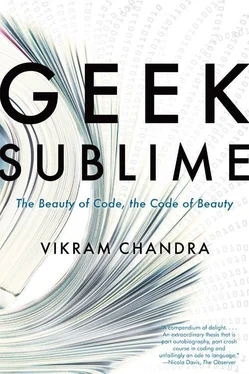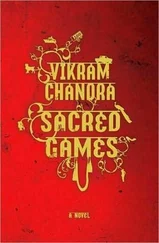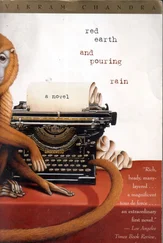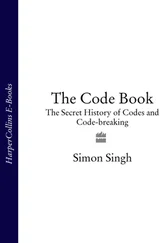4. Toole, Ada, the Enchantress of Numbers , loc. 2867–870.
5. Turing, “On Computable Numbers, with an Application to the Entscheidungs-problem (1936).”
6. Toole, Ada, the Enchantress of Numbers , loc. 2131–133.
7. Gleick, The Information , loc. 2048–052.
8. Cabanne, Dialogues with Marcel Duchamp , 18–19.
9. Fishwick, “Aesthetic Computing.”
10. Hessel, Goodman, and Kotler, “Hacking the President’s DNA.”
11. Kotler, “Synthetic Biology for Dummies, Investors or Both …”; Carlson, “The Pace and Proliferation of Biological Technologies.”
12. “iGEM 2012 HS Is Officially Over!”
13. “Team: Heidelberg LSL.”
14. Swain, “Glowing Trees Could Light Up City Streets,” 21.
15. Brown, “Stanford Team Turns DNA into a Hard Drive.”
16. Church and Regis, Regenesis , 7.
17. Ibid., 248–49.
18. Pollock, “What Was Bhaṭṭa Nāyaka Saying?” 154.
19. Skora, “The Pulsating Heart and Its Divine Sense Energies,” 445–46.
20. Flood, “The Purification of the Body,” 518–19.
21. Skora, “Abhinavagupta’s Erotic Mysticism: The Reconciliation of Spirit and Flesh,” 76.
22. Reprinted with the permission of P.N. Furbank. “Messages from the Unseen World,” The Turing Digital Archive, King’s College, University of Cambridge.
23. Cabanne, Dialogues with Marcel Duchamp , 98.
Acocella, Joan. “Blocked: Why Do Writers Stop Writing?” New Yorker 80, no. 16 (2004): 80–129.
Bailey, Derick. “Dear Open Source Project Leader: Quit Being a Jerk.” LosTechies.com, December 14, 2012. http://lostechies.com/derickbailey/2012/12/14/dear-open-source-project-leader-quit-being-a-jerk/.
Barbrook, Richard, and Andy Cameron. “The Californian Ideology.” Science as Culture 6, no. 1 (1996): 44–72.
Barrett, David. “Why We Don’t Hire.NET Programmers.” Expensify (blog), March 25, 2011. http://blog.expensify.com/2011/03/25/ceo-friday-why-we-dont-hire-net-programmers/.
Bassett, Ross. “Aligning India in the Cold War Era: Indian Technical Elites, the Indian Institute of Technology at Kanpur, and Computing in India and the United States.” Technology and Culture 50, no. 4 (2009): 783–810.
_______. “MIT-Trained Swadeshis: MIT and Indian Nationalism, 1880–1947.” Osiris 24, no. 1 (2009): 212–30.
Bharata Muni, and Adya Rangacharya. The Nāṭyásāstra: English Translation with Critical Notes. Rev. ed. New Delhi: Munshiram Manoharlal Publishers, 1996.
Bhate, Saroja, and Subhash Kak. “Panini’s Grammar and Computer Science.” Annals of the Bhandarkar Oriental Research Institute 72 (1993): 79–94.
Bloch, Joshua. “Extra, Extra — Read All About It: Nearly All Binary Searches and Mergesorts Are Broken.” Google Research Blog, June 2, 2006. http://googleresearch.blogspot.com/2006/06/extra-extra-read-all-about-it-nearly.html.
Bloomfield, Leonard. Linguistic Aspects of Science. In International Encyclopedia of Unified Science 1:4. Chicago: University of Chicago Press, 1939.
Briggs, Rick. “Knowledge Representation in Sanskrit and Artificial Intelligence.” AI Magazine 6, no. 1 (1985): 32–39.
Brockmeier, Joe. “How Casual Sexism Put Sqoot in the Hotseat.” ReadWrite (blog), March 20, 2012. http://readwrite.com/2012/03/20/how-casual-sexism-put-sqoot-in.
Bronner, Yigal, and David Shulman. “’A Cloud Turned Goose’: Sanskrit in the Vernacular Millennium.” Indian Economic & Social History Review 43, no. 1 (March 1, 2006): 1–30. doi:10.1177/001946460504300101.
Brown, Eryn. “Stanford Team Turns DNA into a Hard Drive.” Los Angeles Times , May 26, 2012. http://articles.latimes.com/2012/may/26/science/la-sci-synthetic-biology-q-a-20120526.
Cabanne, Pierre. Dialogues With Marcel Duchamp. Reprint, Boston, MA: Da Capo Press, 1987.
Campbell, Michael. “Where Does One Go to Find the Current ‘Good’ Books to Read? (Or Blogs?)” Programmers.stackexchange.com, August 25, 2011. http://programmers.stackexchange.com/questions/103619/where-does-one-go-to-find-the-current-good-books-to-read-or-blogs.
Carlson, Ron. “The Pace and Proliferation of Biological Technologies.” Biosecurity and Bioterrorism: Biodefense Strategy, Practice, and Science 1, no. 3 (2003): 203–14.
Ceglowski, Maciej. “Dabblers and Blowhards.” Idle Words (blog), April 4, 2006. http://www.idlewords.com/2005/04/dabblers_and_blowhards.htm.
Chakrabarti, Arindam. “Arguing from Synthesis to the Self: Utpaldeva and Abhinavagupta Respond to Buddhist No-Selfism.” In Hindu and Buddhist Ideas in Dialogue: Self and No-Self , edited by Irina Kuznetsova, Jonardon Ganeri, and Arindam Chakrabarti, 199–215. Surrey: Ashgate, 2012.
Christiansen, Tom. “Computers.” Wikiquote.com. Accessed February 3, 2013. http://en.wikiquote.org/wiki/Computers.
Church, George M., and Ed Regis. Regenesis: How Synthetic Biology Will Reinvent Nature and Ourselves. New York: Basic Books, 2012.
“Computer Scientists Build Computer Using Swarms of Crabs.” The Physics arXiv Blog, April 12, 2012. http://www.technologyreview.com/view/427494/computer-scientists-build-computer-using-swarms-of-crabs/.
Conrad, Joseph. Heart of Darkness and Selections from the Congo Diary ( Modern Library Classics ). Edited by Caryl Phillips. New York: Modern Library, 2000. Kindle edition.
Cowley, Malcolm. And I Worked at the Writer’s Trade: Chapters of Literary History, 1918–1978. New York: Viking, 1978.
Dalmia, Vasudha. “Sanskrit Scholars and Pandits of the Old School: The Benares Sanskrit College and the Constitution of Authority in the Late Nineteenth Century.” Journal of Indian Philosophy 24, no. 4 (1996): 321–37.
Davidson, Ronald M. Indian Esoteric Buddhism: A Social History of the Tantric Movement. New York: Columbia University Press, 2002.
Dehejia, Harsha V. The Advaita of Art. Delhi: Motilal Banarsidass Publishers, 1996.
DFectuoso [pseud.]. “Solo Development — Are There Any Famous One-Man-Army Programmers?” Programmers.stackoverflow.com, February 9, 2009. http://programmers.stackexchange.com/questions/47197/are-there-any-famous-one-man-army-programmers.
Dijkstra, E. W. “How Do We Tell Truths That Might Hurt?” ACM SIGPLAN Notices 17, no. 5 (1982): 13–15.
Douglas, Mary. Thinking in Circles: An Essay on Ring Composition. New Haven, CT: Yale University Press, 2007.
DuBow, W. “NCWIT Scorecard: A Report on the Status of Women in Information Technology.” Boulder, CO: NCWIT, 2009.
Eliot, T. S. After Strange Gods: A Primer of Modern Heresy. London: Faber and Faber, 1934.
_______. The Sacred Wood and Major Early Essays. Mineola, NY: Dover Publications, 1997.
Emeneau, Murray B. “Bloomfield and Pānini.” Language 64, no. 4 (1988): 755–60.
______. “India and Linguistics.” Journal of the American Oriental Society 75, no. 3 (1955): 145–53.
Ensmenger, Nathan L. The Computer Boys Take Over: Computers, Programmers, and the Politics of Technical Expertise. Cambridge, MA: The MIT Press, 2010.
Feuerstein, Georg. Tantra: The Path of Ecstasy. Boston: Shambhala, 1998. Distributed in the USA by Random House.
Fine, Cordelia. Delusions of Gender: How Our Minds, Society, and Neurosexism Create Difference. Reprint, New York: Norton, 2011.
Fisher, Jim, ed. The Writer’s Quotebook: 500 Authors on Creativity, Craft, and the Writing Life. New Brunswick, NJ: Rutgers University Press, 2006.
Читать дальше












